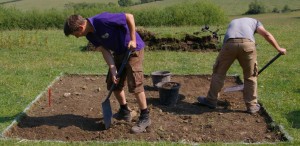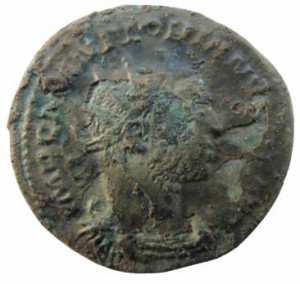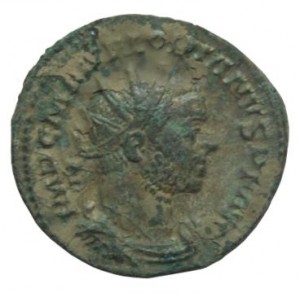
Some of the Bredon Hill hoard
The discovery of the hoard – Richard Henry, FLO for Worcestershire and West Midlands

Richard Henry with some coins from the hoard
On the 18th June 2011 Jethro and Mark spent half an hour enjoying the view from Bredon Hill before picking up their detectors for the afternoon. Within five minutes of detecting they had found the site of the hoard. The initial signal only revealed an iron nail and after removing it the machine was placed back in the hole. Immediately the detector indicated there was a lot more metal at that spot.
After digging deeper large sherds of pottery were discovered before finding the first three coins. The detector registered “overload”. Neither detectorist wanted to get their hopes up but as coins continued to appear it was clear they had found a large coin hoard; both men were removing coins for the next two hours. The soil was then replaced along with the turf; from a distance the find spot was then barely visible.
The hoard was reported to the Portable Antiquities Scheme on the 20th June. Within the hour the Finds Liaison Officer was with the finders and the landowner looking at the find spot, having a preliminary look at the coins and the vessel as well as discussing the possibility of an excavation with the landowner. First impressions of the hoard were that it in all likelihood numbered 5,000 – 10,000 coins and dated to the 3rd century.
The next day the local Archaeological Officer and Worcestershire Historic Environment and Archaeology Service were informed and in the afternoon, the Finds Liaison Officer, Tom Vaughan and Debs Fox went to the site to confirm an excavation would be undertaken at the start of July. A closer examination of the hoard was undertaken and some preliminary photographs were taken. They were mostly in good condition although in need of conservation, a process which would take time and money. As can be seen with the image of the radiate of Probus, most were already identifiable. The vessel in which the coins were deposited was a Severn Valley Ware storage jar dating to the same period.
At the start of July, archaeologists from WHEAS excavated a small trench centred on the find-spot. The aim of the excavation was to establish the archaeological context of the hoard. In particular, the team wanted to establish whether the hoard had been buried in open ground, like most hoards, or on a settlement of some kind, as suggested by the earlier finds, which included a Roman bow brooch. The team included both of the metal-detectorists who found the hoard, as well as the Finds Liaison Officer, David Kendrick and Debs Fox of Museums Worcestershire.

The hoard find spot excavations
The results suggest that the hoard was buried in the ruins of what had been a villa (in the modest, Romano-British, sense of the term). Villas expand and increase in number in the late 3rd century when in other areas of the Roman Empire provinces are suffering. The earliest features found in the trench were the stone foundations of half-timbered buildings. The first foundation was sealed by a deposit of soil and flat stones, interpreted as a surface. That deposit was sealed by another one. The artefacts (including one coin) found in these deposits date from the second century to the late third century.
The second foundation was cut through these deposits and sealed by soils containing earlier artefacts. Two postholes and two stake-holes were found at this level: they may represent a timber building. These features were sealed by a soil containing late third or fourth century pottery and two late third century coins. The latest man-made deposit was a layer of soil and rubble containing late 4th/early 5th century shell-tempered ware. The pit for the hoard was dug through this deposit or the soil that formed above it. The soil contained the latest coin found in the excavation – a copy of a House of Constantine nummus dating to c.355 – 361 AD.
The excavation took two weeks, the post-excavation, conservation and research will take years. It is surprising how long the process will actually take and how much it will cost but the hoard will be an important part of any research into Roman Worcestershire in the later Roman Empire. After the coins were deposited the first task we had to undertake was to separate the soil, naturally dry the coins and supply an initial count. This took long time as anyone who has had to count 3874 coins would understand! Over the next four hours the coins and the soil were painstakingly separated, ultimately the weight of the coins was over 11 kilograms with 3 kilograms of soil – and one centipede! The coins were initially sorted into the groups which would require conservation, including over 900 which were stuck together in clumps.
The coins were then securely secured and left to dry naturally before being collected by the Treasure Team at the British Museum in mid July to be cleaned and then identified so that a Coroner’s report could be written for the inquest.
Conservation and Identification

Richard Henry sorting coins
Throughout the whole process the condition of the coins was crucial. It was essential to clean the coins and separate them so that they could be stabilised, identified and their condition evaluated. Due to the size of the hoard on the 15th July a member of the Treasure team collected the hoard and took it to the British Museum.The coins were cleaned and dried by the Conservation Department at the British Museum. The coins required considerable attention so that the hoard could be used for research and preserved for future generations to admire. As can be seen in the images of a single coin of Florian on the day that they were reported and then after they had been cleaned.In September an “Emperor count” was undertaken so that a Coroner’s report could be written. This is an essential part of the process for the valuation of the hoard and the “Emperor count” was conducted by members of the Coins and Medals Department of the British Museum as well as the Finds Liaison Officer.
The “Emperor count” is perhaps simpler than would be imagined; each emperor was given a different tub. Correct identification was essential so this was a painstaking process. A full detailed list of the “Emperor count” will be discussed in detail in the booklet on the content of the hoard.
So what next?
The hoard is currently going through the treasure process, within the next few months the Coroner’s inquest will be help to decide if the hoard is legally treasure under the terms of the Treasure Act (1996) which is explained on this site under the Treasure section.
After the inquest has been held and it has been declared treasure it is the job of the Treasure Valuation committee to decide a fair market value for the coins so that the finders and landowner can be rewarded as well as giving Museums Worcestershire an opportunity to acquire the hoard.After the hoard has been valued the museum will have 4 months to raise the money so that they can acquire the hoard and preserve the find intact for future generations to admire and academic research.
 Florian pre cleaning
Florian pre cleaning

Florian post cleaning
The Hoard’s contents
The Roman radiate was the main denomination of the 3rd century AD. It is described as a radiate because of the crown often associated with the sun god Sol. Theoretically the radiate was a double denarius but by the 250s the radiate was highly debased. The coins range from 244 to 282 covering a period of 38 years consisting of the coins of 16 different emperors and the wife of Gallienus. There are issues of emperors from the Central Empire and the Gallic Empire where seven rulers held power over Britain and Gaul between 260 and 274.
List of Emperors
Central Empire
- Philip II (244 – 247) 1
- Valerian I (253 – 260) 1
- Saloninus (258 – 260) 2
- Gallienus (253 – 268) 433
- Salonina (253 – 268) 48
- Claudius II (268 – 270) 352
- Divus Claudius (270) 77
- Quintillus (270) 23
- Aurelian (270 – 275) 17
- Tacitus (275 – 276) 15
- Florian (276) 3
- Probus (276 – 282) 36
Gallic Empire
- Postumus (260 – 269) 67
- Laelian (269) 7
- Marius (269) 9
- Victorinus (269 – 271) 817
- Divus Victorinus (271) 1
- Tetricus I (271 – 274) 1,159
- Tetricus II (272 – 274) 485
- Uncertain 212
- Copies 42
- Illegible 67
Total in hoard: 3,874
The Central Empire
The 3rd century was a period of turmoil, rebellions, invasions and civil wars where generals flexed their muscles in an attempt to gain power. The vast majority died a gruesome death at the hands of their opponents and held power for a short amount of time causing chronic financial instability. A period of what can be described as relative stability when considering the 3rd century arrived when Valerian gained control. He and his son Gallienus jointly ruled the empire until Valerian’s death in 260 AD fighting the Sassanian Persians. Valerian was defeated in battle at the head of legions severely depleted by plague. Valerian suffered a gruesome and humiliating death; the sources suggest that molten gold was poured down his throat before he was stuffed with straw.
After years of barely holding onto power, which included the Alamanni raiding Italy itself in 268 Gallienus was assassinated. Claudius II gained control and for two years the empire recovered. Claudius defeated the Goths, claiming the title Gothicus before dying of the plague, probably small pox, his natural death was a rare occurrence in this period. His brother Quintillus was declared emperor but his reign was short lived, lasting between 17 and 177 days depending on the source read.
In 274 Aurelian defeated Tetricus I reuniting the Empire. He rebuilt the walls around Rome and reformed the coinage creating a larger radiate with a higher silver content. Although not a popular ruler Aurelian was successful in contrast to the majority of his predecessors of the 3rd century and he earned the title Restorer of the World. Even so in 275 he was also murdered. His successor Tacitus was already over 70 when he became emperor, he defeated the Goths before dying of fever. His brother Florian became emperor before being defeated by Probus having ruled for only 88 days. Probus appears to have taken a real interest in Britain on which the 3rd century had a profound effect. In 277 he lifted restrictions on growing vines in the province and it became an important source of food and wine producer. It was the start of an agricultural boom. Probus also settled barbarians in Britain before he was assassinated (Three Roman coin hoards from Wiltshire terminating in coins of Probus (AD 276-82), Wiltshire Archaeological and Natural History Magazine 102, pp. 150-9)
in 282.
The Gallic Empire
After the greusome death of his father Valerian Gallienus’ rule began to crumble. He left Postumus in control of Gaul and amid the chaos of invasions in 260 AD Postumus usurped power. A breakaway Empire emerged lasting for the next 14 years.In 260 Postumus usurped and proclaimed himself emperor building his power base around what is now known as Cologne. By 261 Gaul and Britain acknowledged him as Emperor. From the beginning Postumus made it clear he made no bid for power in Rome, his priority was Gaul. Ultimately this was his downfall, and the army were not happy with his decision not to march on Rome.
In 269 Laelian was proclaimed emperor.Laelian was easily defeated after Postumus captured Mainz and he was killed, his rule lasting barely lasting 4 months. Postumus was unable to control his own troops and they turned on him. After his death the Gallic Empire shrunk in size losing control of Britain. Marius was declared emperor after the death of Postumus, his rule lasting barely three months before he was killed by Victorinus. Victorinus was the Praetorian prefect. Victorinus’ rule lasted around 2 years when he constantly struggled to keep provinces within the Gallic Empire, in 271 he was murdered by a jealous husband.
In 271 the Gallic Empire was almost on its knees, power was seized by Tetricus I who made his son Tetricus II Caesar. Tetricus was a provincial governor in Gaul. As with Victorinus, Tetricus struggled to stop defections to the new Emperor Aurelian. He was decisively defeated by Aurelian in 274 when he abandoned his army and allowed them to be massacred. It is said that he was made a governor by Aurelian. In contrast to coins of the Central Empire issues of the Gallic Empire within the hoard are numerous, the most common being Tetricus I, Tetricus II and Victorinus. It was a period of high inflation and a heavily debased currency. This could also be linked to the fact that it is possible that under Tetricus and Victorinus around 5 – 6 million radiates were issued a week. This is a staggering number which was not equalled under the introduction of mechanical coin striking in the 17th and 18th centuries.
Examples from the Bredon Hill hoard
The hoard contains a number of interesting examples. After the death of Marius in 269 AD, Victorinus took control of the Gallic Empire. The early issues did not include the bust of Victorinus, perhaps this is because the mints did not know what their new emperor looked like. Instead they continued to use the bust of Marius with Victorinus’ full name inscribed on the obverse M PIAVVIONIVS VICTORINVS, interestingly a mosaic from Trier states his name as M.PIAONIVS.VICTORINVS.
In 268 Victorinus was co-consul with Postumus and the inscription states that he was tribune of the Praetorian guard, ironically this meant he was supposed to be the protector of the emperor. It appears that Victorinus could be regarded as a womaniser, as in 271 he was murdered by one of his officers whose wife he had tried to seduce. His mother arranged for his deification and Victorinus was declared a god, coins were issued celebrating this event.
A common theme throughout is debasement; coins which were meant to be around 90% silver contained barely 1%. It is interesting to see that under the reformed coinage the fact that each coin had a higher silver content was advertised. The marks PXXI at the bottom of the coin denote the mint and the silver content. It is a stark improvement; although it is still only 20 parts copper to 1 part silver (5%).
Coins in the Roman period were not just issued in the name of the ruling Emperor. There are examples throughout the whole of the Roman Empire of coins depicting and in the name of the Emperor’s wife or mother. There are 48 examples of this within the Bredon Hill hoard, all of one woman, Salonina. She was known as an Augusta and was the wife of the Roman Emperor Gallienus. Although in this period the Emperors were depicted with radiate crowns, females on coins were depicted with a lunar crescent behind the bust, as can be seen with this example.Each coin was struck by hand, consequently errors are common place unlike today when a major error by the mint becomes headline news, as can be seen with some 20ps missing a date from 2008. The most common error is coins being mis-struck, therefore having to be struck twice. Other errors can be seen within the hoard – there are examples where a coin is a hybrid of two types, such as this coin of Claudius II. Or where two bronze discs have been inserted before striking instead of one, the result being one coin with just the Emperors bust and a blank reverse, the other with just the reverse and a blank obverse.